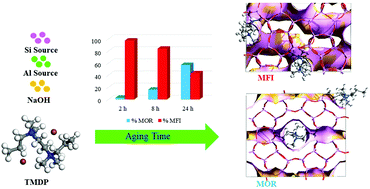Computational elucidation of the aging time effect on zeolite synthesis selectivity in the presence of water and diquaternary ammonium iodide†
Abstract
An example of zeolite selectivity (MFI → MOR) driven by synthesis aging time has been studied. Using N,N,N′,N′-tetramethyl-N,N′-dipropyl-ethylenediammonium diiodide (TMDP) as an organic structure-directing agent (OSDA), the zeolite phases obtained at 2 h (MFI 97%), 8 h (MFI 84%, MOR 16%) and 24 h (MFI 43%, MOR 57%) have been characterized by powder X-ray diffraction. The results suggest that at intermediate aging time, namely 8 h and 24 h, the dominant phase (MFI) is displaced by MOR. Different techniques (FT-IR, Raman, 13C MAS NMR, TGA/DTG and HC microanalysis) have been employed to verify the OSDA integrity and occlusion inside the zeolite micropores as well as to quantify the water and OSDA loading. The 1H MAS NMR of the as-made occluded zeolite was compared with the spectra of TMDP and the recovered OSDA from the sample by extraction with water. The comparison indicated that TMDP was not structurally intact, indicating the chemical transformation of TMDP to imidazolinium homologues through the Hofmann degradation process. Furthermore, careful acidic breakdown of the aluminosilicate shell, covered on the zeolite samples by hydrofluoric acid, revealed that the remaining OSDA had been partially degraded to lower molecular weight ammonium salt, confirmed by 1H NMR and mass spectrometry measurements. A computational study was performed by using a force field based methodology, including accurate loading of water and OSDA in the zeolite (MFI and MOR) unit cells. The results show an important contribution of the presence of water. The samples with larger aging time (8 h and 24 h) incorporate less water and show partial TMDP degradation, whilst at the shortest aging time (2 h), there is a larger water content and TMDP remains intact. The larger accessible volume of MFI justifies that this is the dominant phase at short aging times (large water content) since it can accommodate a larger number of water molecules than MOR. The OSDA partial degradation also plays a role. At longer aging times the partial OSDA decomposition has been considered in the models by including TMDP + Imidaz, which is more stabilized by MOR, whilst at shorter aging times the only OSDA present, TMDP, is better stabilized by MFI.



 Please wait while we load your content...
Please wait while we load your content...